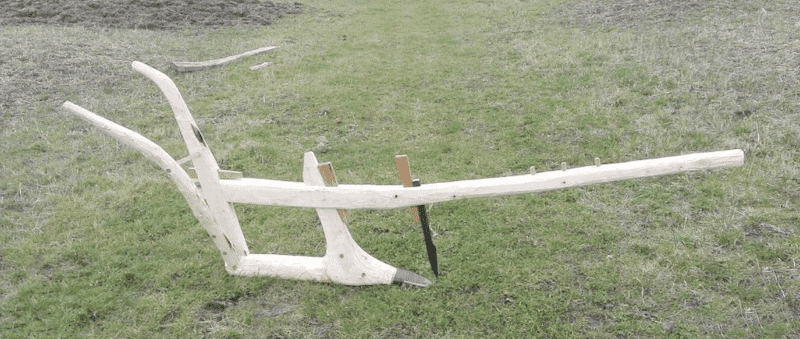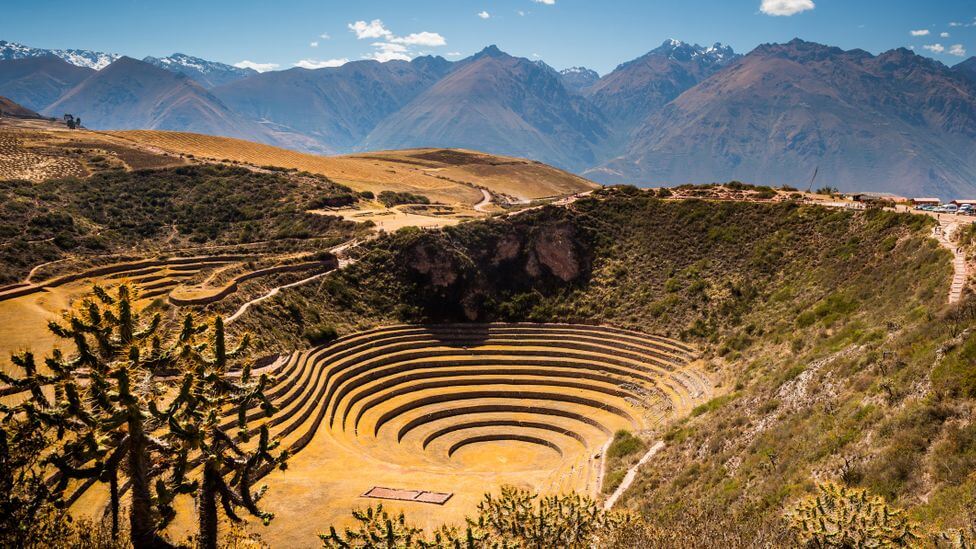
Farming has been an essential part of human life for thousands of years. Throughout history, traditional farming methods have evolved and adapted to suit the needs of different regions and cultures. Indigenous agriculture is still in use today by in many parts of the world and have proven to be effective in sustaining communities and providing a reliable source of food.
Ancient peoples from various regions, such as the Egyptians, Aztecs, Cree, Umatilla, Choctaw, and Incas, were pioneers of traditional farming methods. They developed techniques such as irrigation, crop rotation, and terracing, which allowed them to cultivate crops in arid and rocky terrain. The Egyptians, for example, used the Nile River to provide a source of irrigation, and the annual flooding of the river provided nutrients for the crops. The Umatilla lived along the Umatilla River farming the flood plains of present-day Richland in Eastern Washington. The Choctaw where skilled agriculturalists that farmed the lower flood plains of the Mississippi valley. The Incas in South America used terracing to create flat areas on the steep Andean mountainsides, enabling them to grow crops in areas that were previously unsuitable for agriculture.
Traditional farming methods often involve the use of hand-held Indigenous agriculture tools such as hoes, shovels, and plows. These tools have been used for centuries and are still used today in many farming communities. The plow, for example, is a tool that was invented over 4,000 years ago and is still used in many farming communities.
A traditional plow made from wood and stone is known as an ard plow. The ard plow is one of the earliest types of plows, believed to have been used since ancient times in various parts of the world.
The ard plow consists of a wooden frame with a pointed stone or metal blade attached to the bottom. The wooden frame is attached to a wooden beam or handle that the farmer holds onto as they guide the plow through the soil. The stone blade is used to break up the soil, making it easier to plant seeds.

The ard plow is still used in some parts of the world today, particularly in developing countries. While it has largely been replaced by more modern plows, the ard plow remains an important part of agricultural history and a testament to the ingenuity of ancient farmers who were able to use simple tools to cultivate the land.
Other Indigenous agriculture tools include sickles for harvesting, scythes for cutting grass, and rakes for gathering crops.
In areas with limited rainfall, irrigation is necessary to grow crops. Traditional Indigenous agriculture irrigation include diverting water from rivers and streams, digging wells, and constructing canals. In India, farmers have been using a system of canals for over 2,000 years to irrigate their fields. This system, known as the Indus Valley Civilization, allowed farmers to grow crops in areas that were previously uninhabitable.
Native South American civilizations developed a variety of irrigation methods to support their traditional farming methods, many of which are still used today. Some of the most notable irrigation methods used in South America include:
Andean terraces: Andean terraces are a series of stepped, flat areas carved into the side of a mountain. These terraces help prevent erosion and allow for the cultivation of crops in steep areas. Water is often channeled through a system of canals and small dams to irrigate the crops.
Qanat: Qanats are underground tunnels that were used to transport water from mountain springs to arid regions. They were constructed using a sloping gradient and gravity to transport water, and they were often several kilometers long.
Chinampas: Chinampas are a type of floating garden used in pre-Columbian Mesoamerica, which includes parts of Central and South America. They consist of small, rectangular plots of land that are separated by canals. The canals are filled with water, which helps irrigate the crops grown on the chinampas.
Waru waru: Waru waru is an agricultural technique used by the Aymara people of the Andes. It involves the construction of raised beds that are surrounded by water-filled ditches. The raised beds are filled with fertile soil, and the water helps irrigate the crops.
Slash and burn agriculture, also known as swidden agriculture, is a traditional farming method that involves cutting down and burning trees and vegetation to clear a patch of land for farming. The ash from the burned vegetation provides nutrients for the soil, allowing crops to be grown. This method is often used in tropical regions where the soil is poor, and nutrients are scarce. Some examples of slash-and-burn Indigenous agriculture in ancient South America include:
The Tukanoans: The Tukanoans are a group of indigenous peoples who live in the Amazon Basin in present-day Colombia and Brazil. They practice shifting cultivation, clearing small plots of land by slashing and burning the vegetation. They then plant crops such as cassava, maize, and beans. After a few years, the soil becomes depleted, and the Tukanoans move on to a new plot of land.

The Incas: The Incas, who ruled over a vast empire in present-day Peru, Bolivia, and Ecuador, practiced slash-and-burn agriculture in the highlands. They would clear the vegetation on the steep slopes of the Andes mountains, burning the vegetation to create terraced fields. They would then plant crops such as maize, quinoa, and potatoes. The terraced fields helped prevent soil erosion and allowed the Incas to grow crops in areas where the soil was thin.
The Marajoara: The Marajoara were an ancient civilization that lived in the Amazon Basin in present-day Brazil. They practiced slash-and-burn agriculture on the floodplains of the Amazon River, clearing the vegetation by burning it. They would then plant crops such as maize, cassava, and beans. The Marajoara also created a system of canals to drain the floodplains and control the water level.
Shifting cultivation is a traditional farming method where farmers move from one area to another, leaving the previous area to regenerate. This method is often used in areas with poor soil and limited rainfall. The farmer clears a patch of land, plants crops, and then moves on to a new area after a few years. The previous area is left to regenerate, allowing the soil to recover. Some examples of shifting cultivation in Native America include:
The Maya of Mesoamerica: The Maya practiced shifting cultivation in the rainforest regions of present-day Mexico, Belize, Guatemala, and Honduras. They would clear a patch of forest by cutting down trees and underbrush, and then burn the remaining vegetation. The ash from the burned plants would provide nutrients for the soil, allowing them to grow crops such as maize, beans, and squash. After several years, the soil would become depleted, and the Maya would move on to a new patch of forest.
The Iroquois of the Northeast: The Iroquois practiced shifting cultivation in the forests of present-day New York and Pennsylvania. They would clear an area of forest by girdling trees and burning the underbrush. They would then plant crops such as corn, beans, and squash in the cleared area. After a few years, the soil would become depleted, and the Iroquois would move on to a new area.
The Ojibwe of the Great Lakes: The Ojibwe practiced shifting cultivation in the forests of present-day Michigan, Wisconsin, and Minnesota. They would clear a new forest by cutting down trees and burning the underbrush. They would then plant crops such as wild rice in the cleared area. After a few years, the soil would become depleted, and the Ojibwe would move on to a new forest.
Crop rotation is a traditional farming method where farmers grow different crops in the same field each year. This helps to maintain soil fertility by alternating between crops that require different nutrients. For example, legumes such as peas or beans can be grown one year, followed by grains such as wheat or barley the following year. The legumes fix nitrogen in the soil, providing nutrients for the grains. Some examples of crop rotation by native peoples in Canada include:
The Haudenosaunee (Iroquois) Confederacy: The Haudenosaunee people, who lived in the northeastern United States and southeastern Canada, including present-day Ontario, practiced a three-sisters Indigenous agriculture crop rotation system. They would plant corn, beans, and squash together in a single plot of land. The corn provided a trellis for the beans to climb, while the beans provided nitrogen to the soil. The squash helped to suppress weeds and retain moisture in the soil.
The Cree: The Cree people, who live in northern Canada, including present-day Saskatchewan and Manitoba, practiced crop rotation with wild rice. They would plant wild rice in shallow water in a marshy area. After a few years, the soil would become depleted, and the Cree would move to a new area and plant other crops such as potatoes, beans, and corn.
The Inuit: The Inuit, who live in the Arctic regions of Canada, including present-day Nunavut and the Northwest Territories, practiced Indigenous agriculture crop rotation with hunting and fishing. They would move their hunting and fishing camps from one location to another, allowing the land and waterways to rest and recover before returning to the area.
Terracing is a traditional farming method that involves creating step-like ridges on sloping land to reduce soil erosion and help retain moisture. This method allows farmers to grow crops on steep slopes, which would otherwise be unsuitable for agriculture. Many indigenous peoples in South America and Asia developed their own unique terracing techniques to cultivate crops in challenging terrain. Some examples of terracing by native peoples in South America and Asia include:

The Inca Empire: The Inca Empire, which ruled over present-day Peru, Bolivia, and Ecuador from the 13th to the 16th century, was known for its extensive Indigenous agriculture terracing techniques. The Incas created thousands of terraces on the steep slopes of the Andes Mountains to cultivate crops such as maize, potatoes, and quinoa. The terraces were built with stones and earth and were irrigated using a complex system of canals and aqueducts.
The Ifugao people: The Ifugao people, who live in the mountainous region of northern Luzon in the Philippines, are known for their rice terraces. The Ifugao have been cultivating rice using terracing techniques for over 2,000 years. Their terraces, which are built into the steep slopes of the mountains, are supported by stone walls and irrigated using a system of canals and aqueducts.
The Yuanyang rice terraces: The Yuanyang rice terraces are a series of terraced rice paddies in southern Yunnan province in China. The terraces were created by the Hani people, an ethnic minority group in China, over 1,300 years ago. The terraces, which cover over 13,000 hectares, are built into the steep slopes of the mountains, and are irrigated using a complex system of channels and reservoirs.
Intercropping is a traditional farming method in which two or more crops are grown together in the same area to promote mutual benefits. Many Native American tribes in the Southwest United States, including the Pueblo and Navajo people, practiced intercropping as part of their traditional Indigenous agriculture techniques. Some examples of intercropping by native peoples in the Southwest United States include:
The Three Sisters: The Three Sisters is a traditional intercropping technique used by many Native American tribes in the Southwest United States, including the Hopi, Zuni, and Pueblo people. This method of Indigenous agriculture intercropping refers to corn, beans, and squash, planted together in the same plot of land. The corn provides a trellis for the beans to climb, while the beans fix nitrogen in the soil, which benefits the corn and squash. The squash helps to suppress weeds and retain moisture in the soil.
Companion planting: Companion planting is another intercropping technique used by many Native American tribes in the Southwest United States. For example, the Navajo people would plant corn, beans, and melons together in the same plot of land. The beans would climb the corn, while the melons would help to shade the soil, retain moisture, and repel pests.
The Navajo four-crop rotation: The Navajo four-crop rotation is a traditional intercropping technique used by the Navajo people. The Navajo would plant corn, beans, squash, and melons in the same plot of land, rotating the crops every year. The beans would fix nitrogen in the soil, which benefits the corn and squash, while the melons would help to shade the soil and retain moisture.
Seed saving is a traditional farming method where farmers collect and store seeds from mature crops to be used for planting in the next growing season. This practice allowed native peoples to maintain a supply of seeds that are adapted to their local climate and soil conditions. Indigenous peoples would carefully select seeds from the best-performing crops, which are resistant to pests, disease, and weather conditions. These seeds are then dried and stored until they are needed for planting.
Natural fertilizers used by Indigenous agriculture were an essential component of traditional farming methods and all that was available for use by Indigenous agriculture. These fertilizers were made from organic materials, such as animal manure, compost, and green manure, which provided nutrients to the soil to promote healthy plant growth. Animal manure is one of the most common natural fertilizers used in traditional farming methods. It is rich in nutrients such as nitrogen, phosphorus, and potassium, which are essential for plant growth. Composting is a process of breaking down organic materials such as food and animal carcass waste into a nutrient-rich soil amendment. Green manure, resulting from the rewilding of pre-cropped land, could be plowed back into the soil to re-fertilize soil for future crop plantings.
Natural pest control was an essential part of traditional farming methods. Indigenous peoples often used natural methods to control pests, such as planting certain plants that repel pests or introducing predators that eat the pests. Companion planting is a method of planting different crops together that complement each other in terms of nutrient requirements, pest control, and other factors. For example, planting marigolds with tomatoes can help repel pests such as aphids and whiteflies.
The ancient biochar soil in the Amazon Basin is a type of soil that was created by indigenous peoples in the region over thousands of years. The soil is characterized by the presence of biochar, a type of charcoal created from organic materials such as wood, bones, and plant matter. The biochar was created by burning vegetation and other organic materials in a low-oxygen environment, a process known as pyrolysis.
The indigenous peoples of the Amazon Basin used biochar soil as a traditional farming method to cultivate crops such as maize, beans, and cassava. The biochar helped to improve soil fertility and nutrient retention, allowing for more efficient use of resources and higher crop yields. The biochar also helped to retain moisture in the soil, making it more resilient to drought and other environmental stresses.
The ancient biochar soil in the Amazon Basin is estimated to cover an area of over 6 million hectares, making it one of the largest and most complex anthropogenic Indigenous agriculture landscapes on Earth. The soil was created over thousands of years, with successive generations of indigenous peoples adding new layers of biochar to the soil. The soil is still used by some indigenous communities today and is seen as an important example of sustainable and regenerative agriculture.
The discovery of the ancient biochar soil in the Amazon Basin has challenged the long-held view that the region was largely untouched by human activity before European colonization. It has highlighted the ingenuity and sophistication of indigenous peoples in the region, and their deep knowledge of the natural world.